What was it like to train in the Soviet Union in the 1960s? At what age did they start? What were their gyms like? What did their training manuals look like?
Let’s take a look at some documents from the archives to find out…
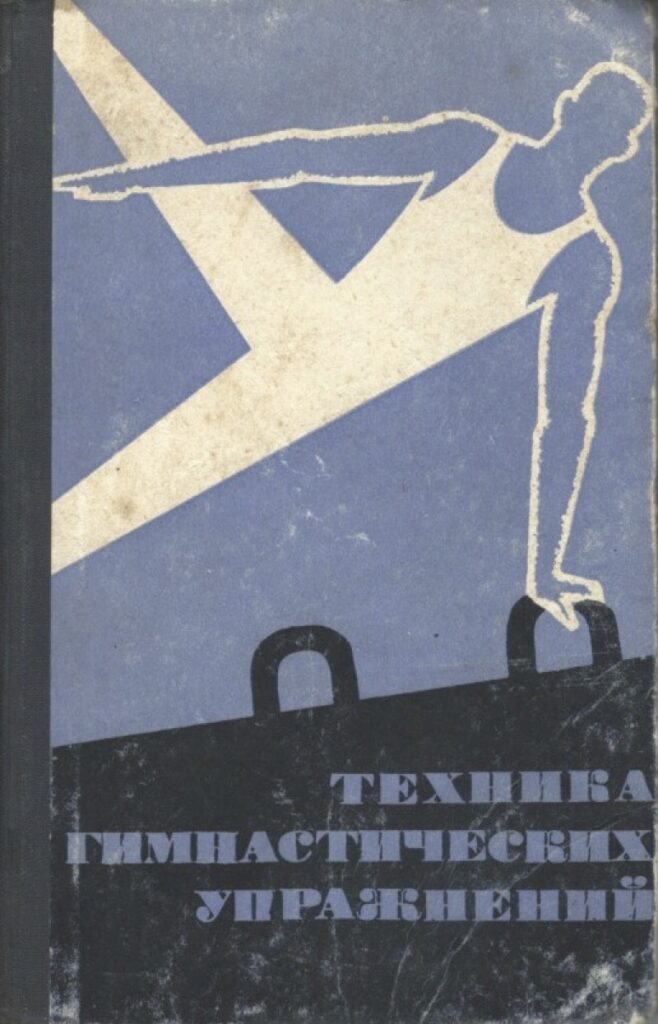
Soviet Training Context
Before we crack open the training guide, let’s quickly understand how the Soviet gymnasts trained at the time. In February of 1968, Modern Gymnast ran a translation of a Yugoslav article about the Soviet gymnastics system.
There are sports schools in every major city. The gymnasts are hand-picked.
Training schools for all sports exist in all major cities of the USSR. Today the enrollment in these schools is the sole opportunity for young people who want to go out for sports. It is impossible to imagine that anyone can set a record or receive a medal by any other means. In these schools training is conducted under the best conditions by highly qualified professionals.
Children’s schools for sports are formed in order to fabricate young athletes; that is, in order to prepare them both physically and mentally for attaining the highest world and Olympic records. Because of this goal, these schools will admit only those who, on the basis of different tests and observations, show exceptional skill in sports; that is, those for whom expected results will be obtained.
The gymnasts enter these schools at the age of 10. The first two years are spent on basics, training 2-3 hours per day, 3 to 4 times per week.
The first two years a child spends in these schools are considered a preparatory period; that is, during this time most attention is paid to development of psychophysical qualities-development of feeling for good posture, rhythm, and movement to music. This is the preparation for harder exercises to follow.
[Equipment is] used for development of strength. Many exercises are done on the floor to music; others on the bars. Children often supervise one another while doing easier exercises.
A group of 6-8 boys or girls of approximately the same age is created. They spend 2-3 hours daily 3-4 times a week doing exercises.
Note: As the gymnasts aged and progressed, they undoubtedly trained more. In 1965, the Estonian newspaper Spordileht ran a feature on Larisa Petrik. She was asked if she had difficulty keeping up with school. She admitted that she did. She felt like she was not keeping up with her classmates:
“It does,” Larisa admitted frankly. “Daily training, frequent trips do not allow me to keep up with my classmates. But I’m trying. I only had B’s in the second quarter.”
Spordileht, March 29, 1965
«Segab,» tunnistas Larissa avameelselt. «Igapäevased treeningud, sagedased sõidud ei lase mul klassikaaslastega sammu pidada. Kuid ma püüan. Teisel veerandil olid mul ainult neljad »
Note: You can read an English translation of the full Petrik interview here.
According to the article, the best schools at the time were…
Kyiv House of Sports for WAG and Moscow House of Sports, “Krila Sovjetov” for MAG.
There is debate over age. Some coaches want gymnasts to start younger, as young as 6 or 7.
While Plisko believes that children should start training at the age of 6 or 7, he emphasizes the fact that the only thing that really matters is a satisfactory program for children of this age. Well-known Shlemina thinks that the age of 10 is the most favorable. The fact that at the present time children’s schools for sports admit children beginning with 10 years of age shows that most trainers support the latter’s opinion.
But others think that gymnasts should start competing only at the age of 18.
On the other hand, the great specialist D. S. Mishakov believes that specialization should begin somewhat later; that is, when the body strengthens and becomes ready for great exertion. According to him, competition in athletics should begin at an age no sooner than 18. Only such gymnasts can stay at the top for longer periods of time. In order to prove his point, Mishakov gives as an example his students Latynina and Shakhlin who were at the top for 10 years and compares them to Larisa Petrik who became the USSR champion when she was 15 and came down to 5th place last year. Also, she often suffers from injuries and this makes her further success uncertain.
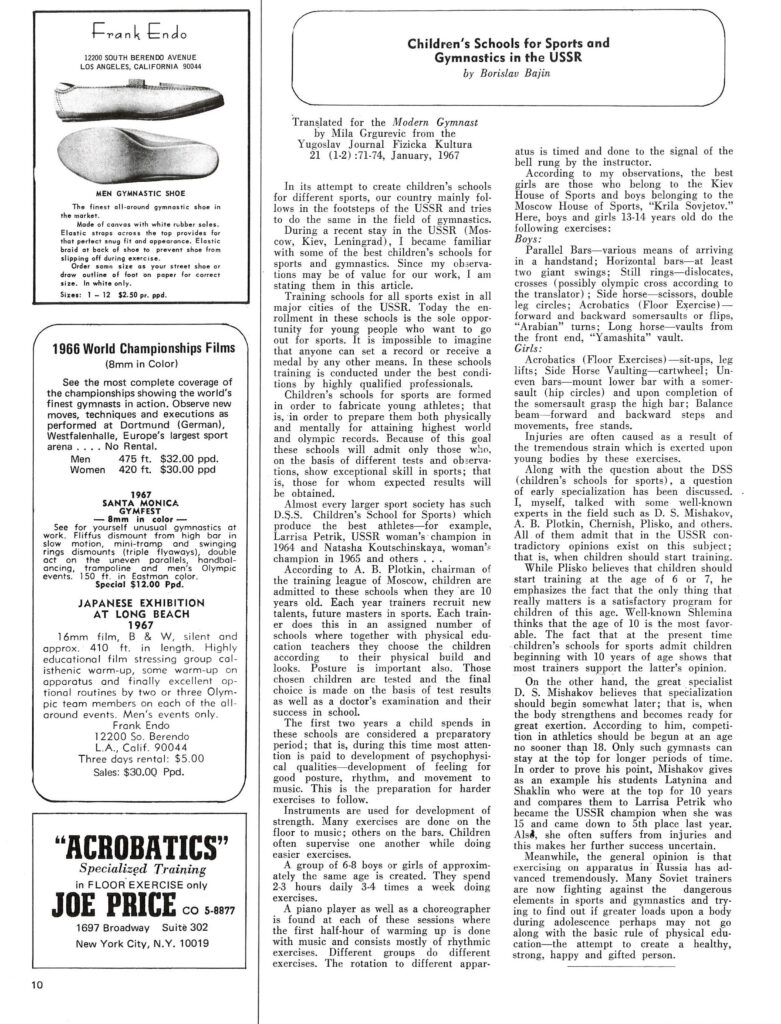
A Look Inside a Soviet Gym
You can watch Zinaida Druzhinina training with coach Vladimir Shelkovnikov in 1967. Boris Astafiev also makes an appearance.
Note: The video mixes together several generations of gymnastics. For example, the video flashes back to Galina Urbanovich, who competed in the 1952 Helsinki Olympics.
My thought bubble: I love this video because it shows how small gyms used to be. The floor exercise area is right up against the wall. Equipment and mats were stored along the walls and had to be brought out for training. They didn’t have 5 sets of bars and 10 balance beams.
Also, how many readers learned fulls this way?
Техника гимнастических упражнений
In 1967, Физкультура и спорт (Physiculture and Sport), the main sports publisher of the Soviet Union, printed a book of gymnastics called Техника гимнастических упражнений (Gymnastics Technique).
Here are some of the skills that caught my eye while I perused the book. As far as I know, the following elements weren’t being competed internationally at the time. If they were, they were quite rare.
Note: I wasn’t alive in 1968, so my knowledge is limited to extant videos and the skills listed in gymnastics magazines from the time period.
Back full dismount off beam (Figure 199): On the women’s side, one page stood out. It’s the page with the back full off beam. In 1967, twisting dismounts weren’t in vogue. That said, one year later, both Čáslavská and Tourischeva performed the dismount in Mexico City.
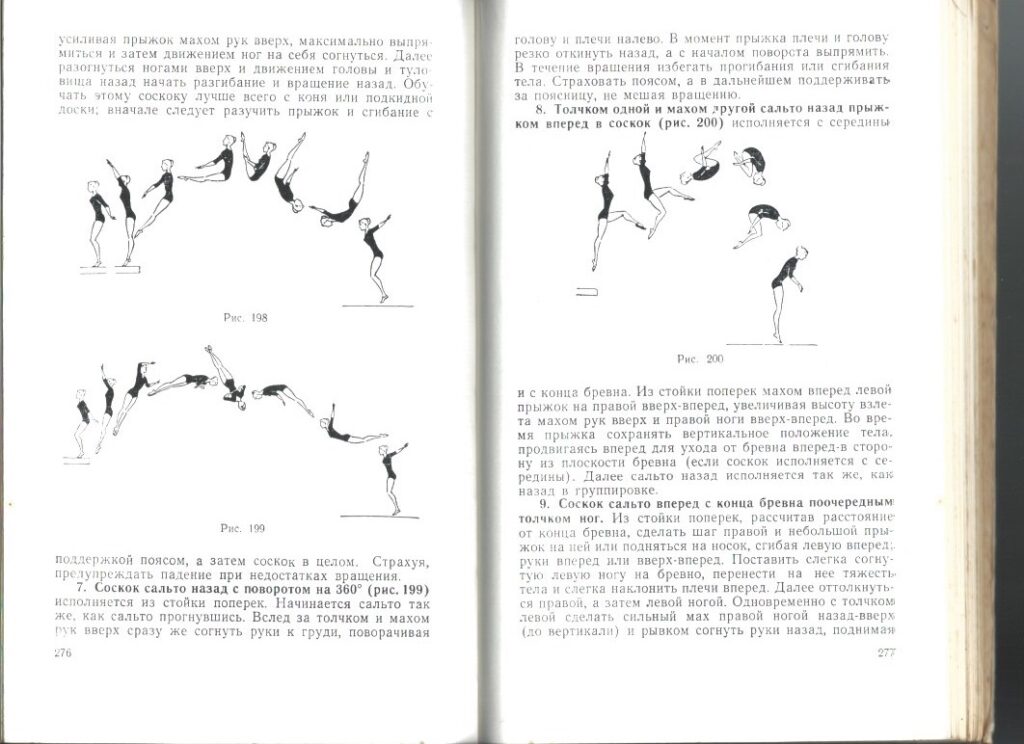
Front tuck onto the horse + front handspring off (Figure 213): On the men’s side, two vaults stood out:
- The front handspring + front tuck off the horse (Figure 212)
- The front tuck onto the horse + front handspring off (Figure 213)
In 1967, men were primarily competing Yamashitas and occasionally twisting vaults — not flipping vaults — at the international level. So, a handspring + front tuck (Figure 212) would have been rare.
In fact, a handspring + front tuck would have been a refreshing break from the monotony of men’s vault at international competitions. During a 1969 meeting of international coaches organized by the FIG, there was a proposal to ditch men’s vault because it was so boring and monotonous. Arthur Gander (FIG President) agreed:
Gander followed Ivancevic by stating that long horse must look for new tactics and be made more attractive to all. “No one wants to sit through the same exercise over and over. People are squirming in their seats.”
Modern Gymnast, June/July 1969
We’ll discuss this meeting at length in the near future.
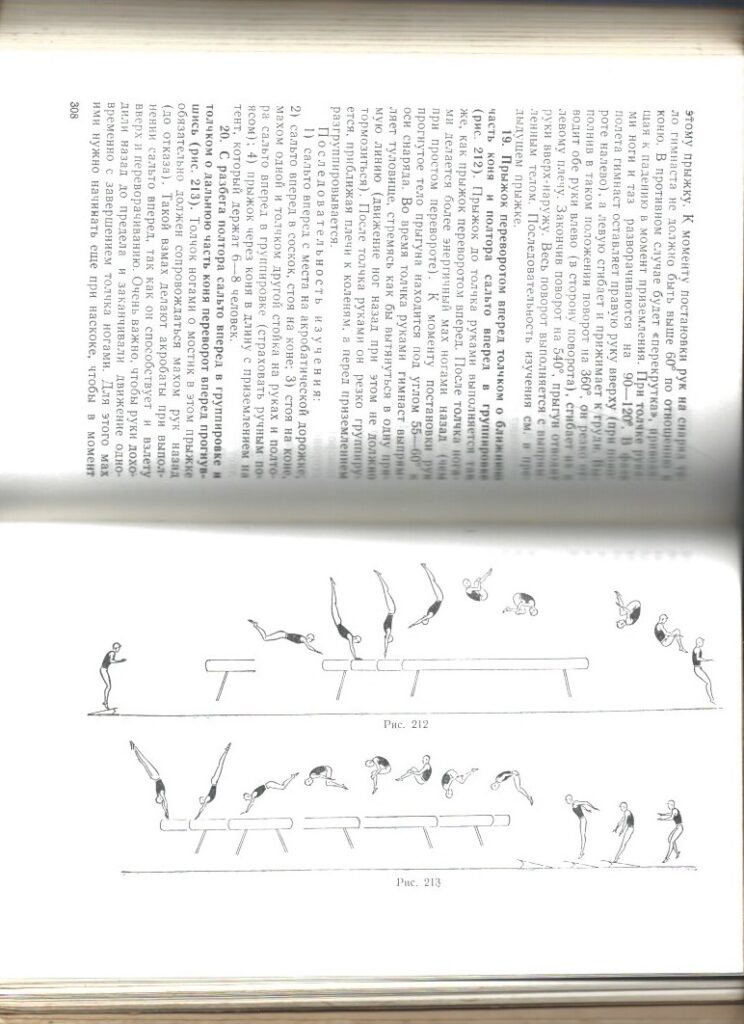
I like how the illustration makes it look like the figure is vaulting over a balance beam. 🙂
Double side somi on floor (Figure 239): While the double back had been competed at the 1964 Olympics by Rusty Mitchell of the USA, the double side somi had not made an appearance at a major international competition. (As far as I know.)
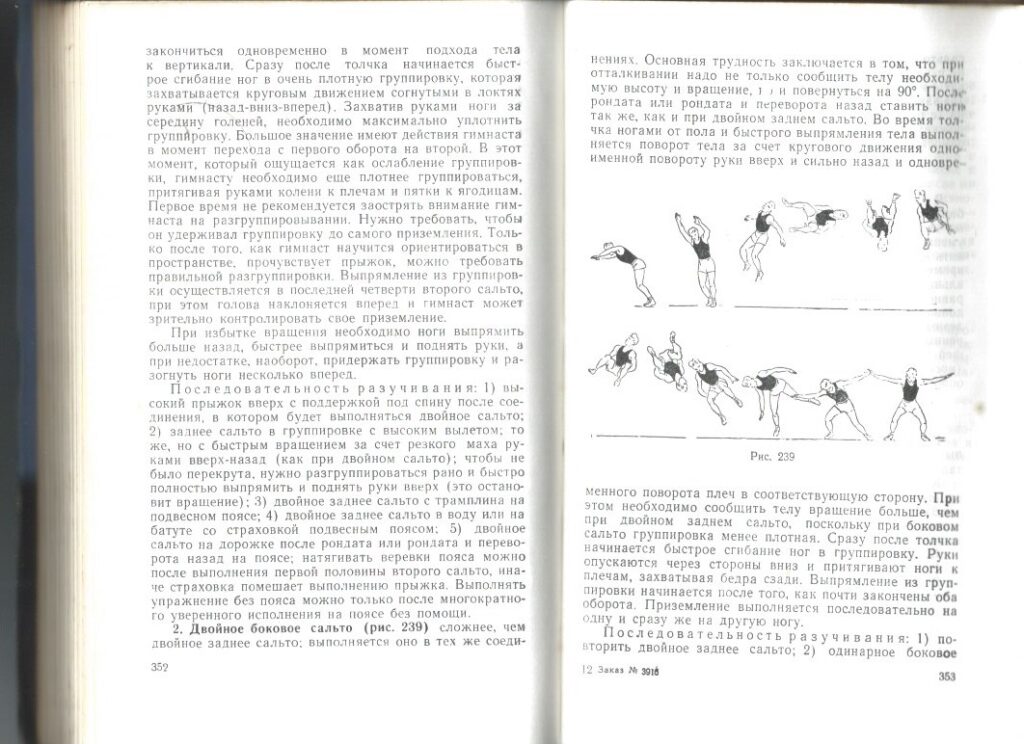
Where did these skills come from if they weren’t being competed internationally?
That’s a great question. The text doesn’t give any hints. I think there are a couple of logical possibilities.
Potential Explanation #1
They are theoretical skills that the authors thought gymnasts could compete in the future. In the gymnastics community, it wasn’t uncommon to talk about theoretical skills.
Outside the Soviet context, the Jaeger release appeared in a February 1963 issue of Modern Gymnast. That’s roughly a decade before Bernd Jäger debuted the skill. In 1963, the release move was billed as a theoretical skill that gymnasts could potentially start training.
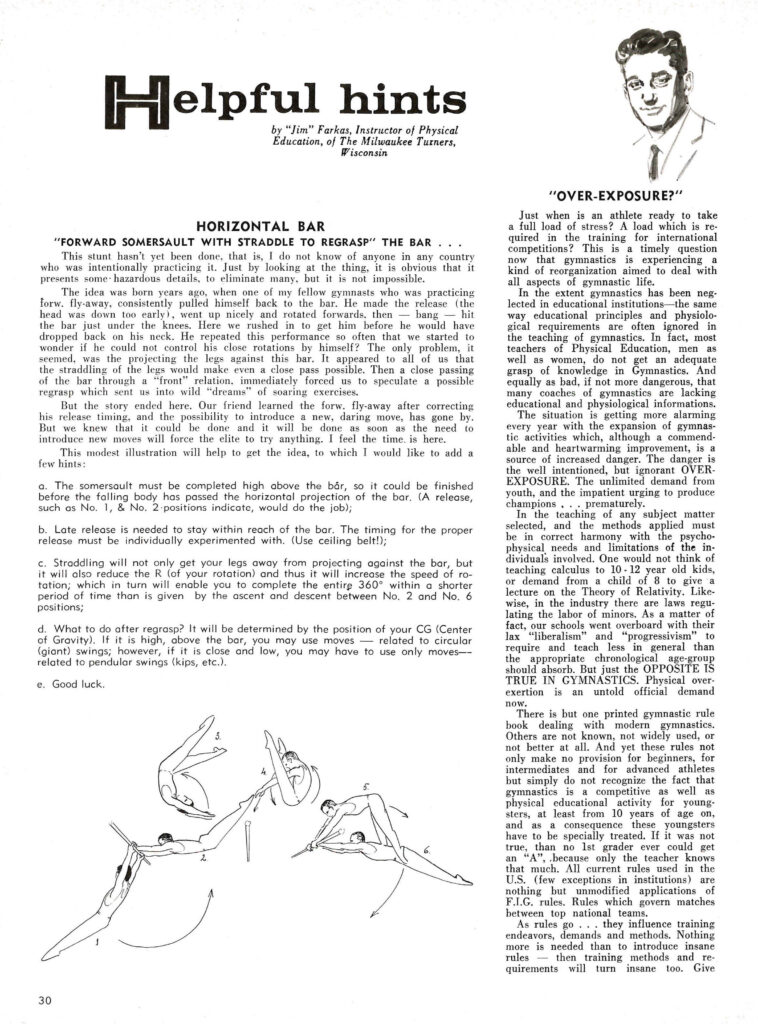
Potential Explanation #2
They are skills that were being performed or trained domestically in the Soviet Union.
Outside the Soviet context, the U.S. gymnast Hal Shaw performed a Tsukahara vault at the 1968 NCAA Championships before Tsukahara debuted his eponymous vault in international competition. In the United States, the Tsukahara was originally called an “O-Shaw.”
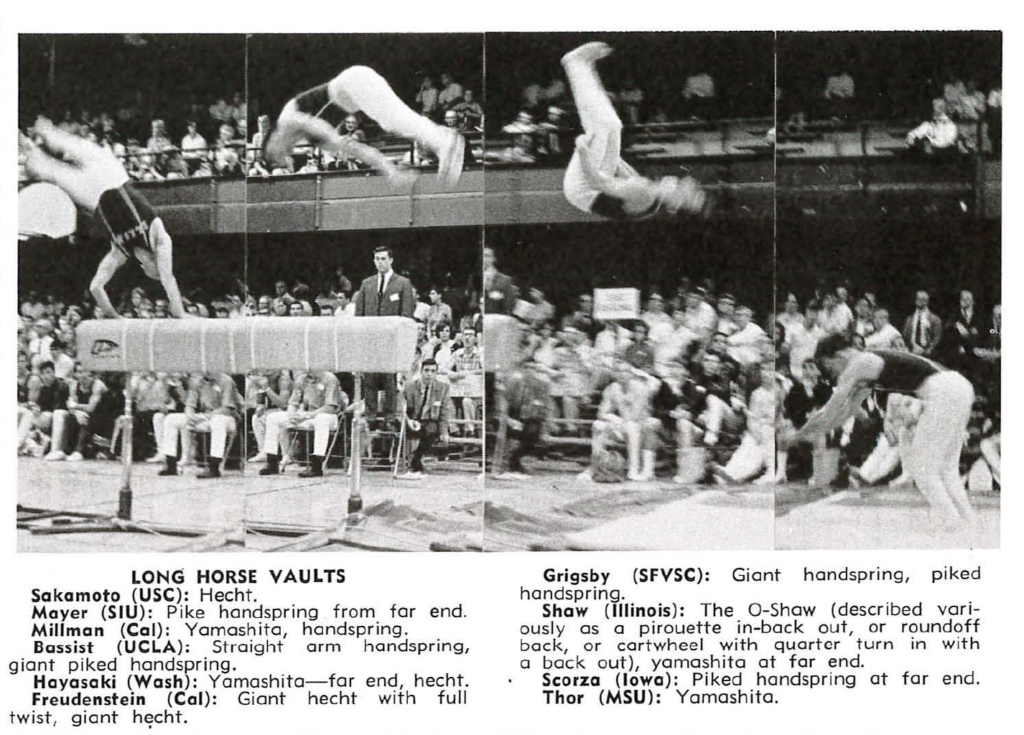
Another Example
A hecht + front tuck was a vault that gymnasts were experimenting with during the late 1960s.

So, it’s possible that the Soviet gymnasts could have been training these skills — if not competing them domestically.
The Skills That Were Being Competed Domestically in the USSR in 1967
If Soviet gymnasts were competing the elements highlighted in the previous section, they didn’t appear in the extant domestic footage from 1967.
But you can see other skills that the Soviet team was competing domestically in 1967. They definitely took risks, but those risks weren’t always clean.
On the Women’s Side
Onodi before Onodi
You can see Kuchinskaya attempting (cheating) what we’d call an Onodi today. (On the men’s side, Franco Menichelli competed this skill at the 1964 Tokyo Olympics.)
Usually, Kuchinskaya did a layout ½ step out for that pass.
Half-On + Full-Off
In 1966, Pauline Prestidge, Great Britain’s coach, noted that a Soviet gymnast warmed up this vault in the training hall at the World Championships. But the vault wasn’t competed at the World Championships.
Here, we can see Dzhanukashvili competing a half-on + full-off on vault in 1967.
Thanks to Nico for helping me ID these gymnasts and for summarizing parts of the book above.
On the Men’s Side
Double Tuck off Parallel Bars
Here’s one of the first double tucks done off parallel bars. (Laiho of Finland performed the dismount at the 1966 World Championships.)
Double Fulls on Floor
Both Vashchaev and Voronin attempted double fulls on floor. They were rough.
Double fulls off High Bar
Lisitsky nailed that dismount!
Gym Nerdery for the Sake of Gym Nerdery
This post doesn’t really have a point. It’s just meant to give you a glimpse into the world of Soviet gymnastics in the late 1960s.
It’s knowledge for the sake of knowledge.
It’s gym nerdery for the sake of gym nerdery.
It’s looking at old books for the sake of looking at old books.
2 replies on “1967: Training in the Soviet Union”
But I like random gym nerdery.
But it’s a fantastic insight! Thanks.